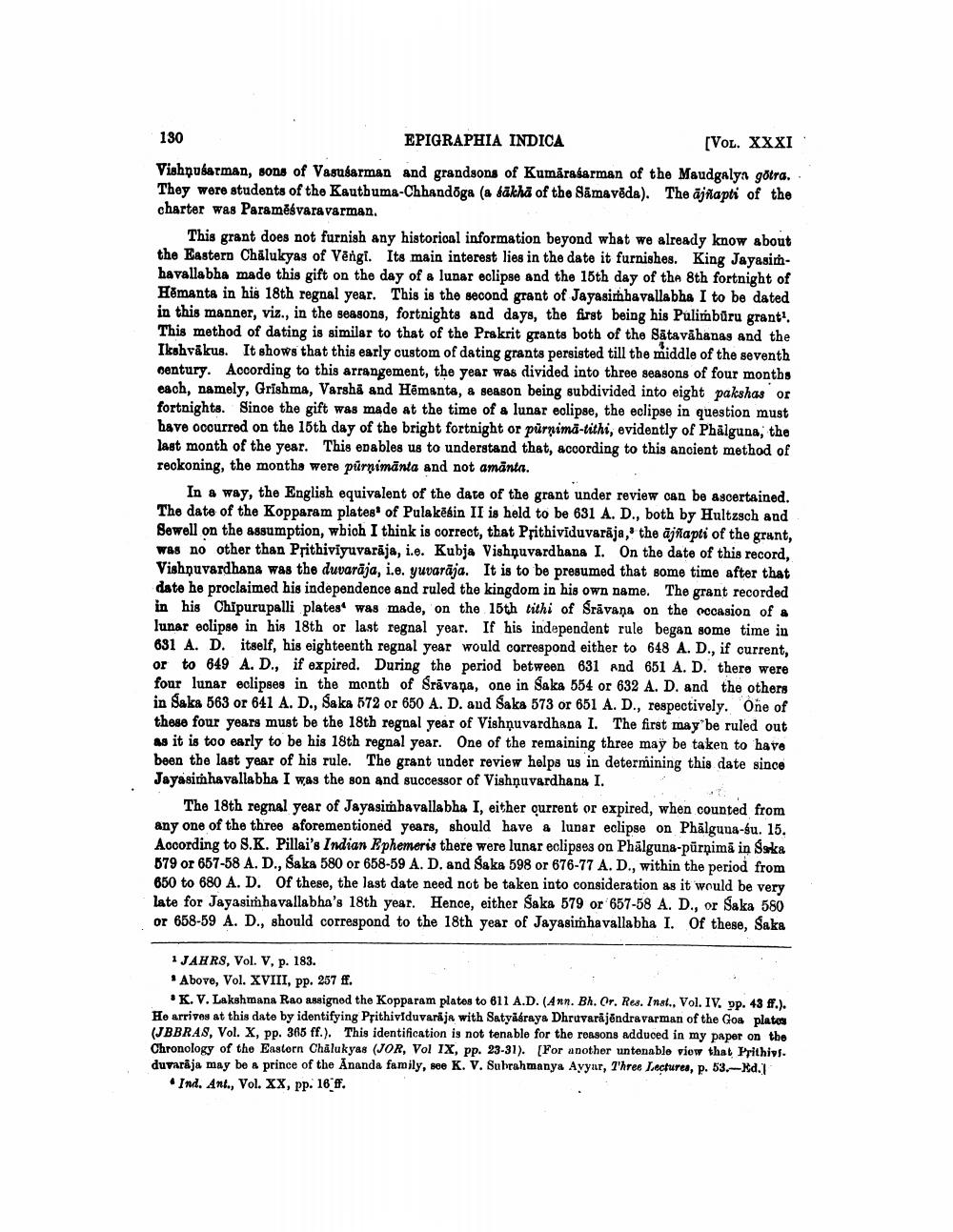________________
130
EPIGRAPHIA INDICA
[VOL. XXXI
Vishnusarman, sons of Vasusarman and grandsons of Kumarasarman of the Maudgalya götra. They were students of the Kauthuma-Chhandōga (a sakha of the Samaveda). The ajñapti of the charter was Paramĕávara varman.
This grant does not furnish any historical information beyond what we already know about the Eastern Chalukyas of Vengi. Its main interest lies in the date it furnishes. King Jayasimhavallabha made this gift on the day of a lunar eclipse and the 15th day of the 8th fortnight of Hemanta in his 18th regnal year. This is the second grant of Jayasimhavallabha I to be dated in this manner, viz., in the seasons, fortnights and days, the first being his Pulimbüru grant1. This method of dating is similar to that of the Prakrit grants both of the Satavahanas and the Ikshvākus. It shows that this early custom of dating grants persisted till the middle of the seventh century. According to this arrangement, the year was divided into three seasons of four months each, namely, Grishma, Varsha and Hemanta, a season being subdivided into eight pakshas or fortnights. Since the gift was made at the time of a lunar eclipse, the eclipse in question must have occurred on the 15th day of the bright fortnight or purnima-tithi, evidently of Phalguna, the last month of the year. This enables us to understand that, according to this ancient method of reckoning, the months were purnimanta and not amanta.
In a way, the English equivalent of the date of the grant under review can be ascertained. The date of the Kopparam plates of Pulakesin II is held to be 631 A. D., both by Hultzsch and Sewell on the assumption, which I think is correct, that Prithivīduvaraja, the ajñapti of the grant, was no other than Prithiviyuvaraja, i.e. Kubja Vishnuvardhana I. On the date of this record, Vishnuvardhana was the duvaraja, i.e. yuvaraja. It is to be presumed that some time after that date he proclaimed his independence and ruled the kingdom in his own name. The grant recorded in his Chipurupalli plates was made, on the 15th tithi of Sravana on the occasion of a lunar eclipse in his 18th or last regnal year. If his independent rule began some time in 631 A. D. itself, his eighteenth regnal year would correspond either to 648 A. D., if current, or to 649 A. D., if expired. During the period between 631 and 651 A. D. there were four lunar eclipses in the month of Sravana, one in Saka 554 or 632 A. D. and the others in Saka 563 or 641 A. D., Saka 572 or 650 A. D. and Saka 573 or 651 A. D., respectively. One of these four years must be the 18th regnal year of Vishnuvardhana I. The first may be ruled out as it is too early to be his 18th regnal year. One of the remaining three may be taken to have been the last year of his rule. The grant under review helps us in determining this date since Jayasimhavallabha I was the son and successor of Vishnuvardhana I.
The 18th regnal year of Jayasimhavallabha I, either qurrent or expired, when counted from any one of the three aforementioned years, should have a lunar eclipse on Phalguna-su. 15. According to S.K. Pillai's Indian Ephemeris there were lunar eclipses on Phalguna-purnima in Saka 579 or 657-58 A. D., Saka 580 or 658-59 A. D. and Saka 598 or 676-77 A. D., within the period from 650 to 680 A. D. Of these, the last date need not be taken into consideration as it would be very late for Jayasimhavallabha's 18th year. Hence, either Saka 579 or 657-58 A. D., or Saka 580 or 658-59 A. D., should correspond to the 18th year of Jayasimhavallabha I. Of these, Saka
1 JAHRS, Vol. V, p. 183.
Above, Vol. XVIII, pp. 257 ff.
K. V. Lakshmana Rao assigned the Kopparam plates to 611 A.D. (Ann. Bh. Or. Res. Inst., Vol. IV. pp. 43 ff.). He arrives at this date by identifying Prithividuvarāja with Satyaáraya Dhruvarajendra varman of the Goa platos (JBBRAS, Vol. X, pp. 365 ff.). This identification is not tenable for the reasons adduced in my paper on the Chronology of the Eastorn Chalukyas (JOR, Vol IX, pp. 23-31). [For another untenable view that Prithivs. duvaraja may be a prince of the Ananda family, see K. V. Subrahmanya Ayyar, Three Lectures, p. 53.-Ed.]
Ind. Ant., Vol. XX, pp. 16 ff.




